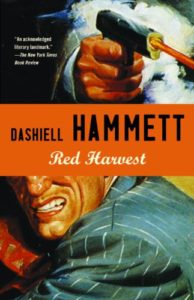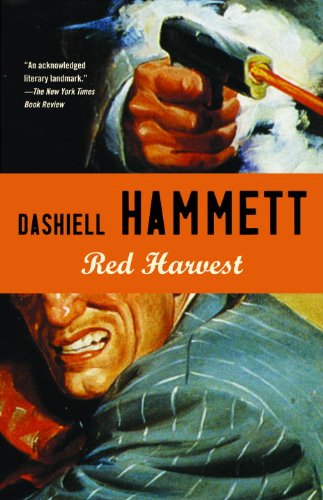
Maybe he wasn’t the original hard-boiled detective. But he was certainly among the first. His creator, Dashiell Hammett, called him “the Continental op.” And the New York Times termed Hammett “the dean of the… ‘hard-boiled’ school of detective fiction” in its obituary in 1961.
The debut of the hard-boiled detective
The tough guy made his first appearance in Red Harvest, the first of Hammett’s five novels. Hammett is better known as the author of The Maltese Falcon and The Thin Man, both of which are familiar to fans of classic films. But it was Red Harvest that Time magazine singled out, including the novel on its list of the 100 best English-language novels published between 1923 and 2005. Red Harvest was first published in book form in 1929, following its serialization in four parts in the mystery magazine Black Mask in 1928-29.
Hammett’s dated writing style
On reading nearly a century after its publication, the book comes across as distinctly dated. Hammett’s vernacular prose is grounded in the slang of the 1920s. The result is a style that seems as stilted as the over-precise diction of Victorian times. But it has its charm as a period piece. Here’s one character describing another minor figure in the story:
“‘His real moniker is Al Kennedy. He was in on the Keystone Trust knock-over in Philly two years ago, when Scissors Haggerty’s mob croaked two messengers. Al didn’t do the killing, but he was in on the caper. He used to scrap around Philly. The rest of them got copped, but he made the sneak. That’s why he’s sticking out here in the bushes. That’s why he won’t never let them put his mug in the papers or on any cards. That’s why he’s a pork-and-beaner when he’s as good as the best. See? This Ike Bush is Al Kennedy that the Philly bulls want for the Keystone trick.'”
Red Harvest (Continental Op #1) by Dashiell Hammett ★★★★☆
“Hard skin all over what’s left of my soul”
The nameless Continental op is an operative of the Continental Detective Agency, San Francisco branch, much as Hammett himself was a private investigator for the Pinkerton Detective Agency before he turned to full-time writing. He describes himself as “a fat, middle-aged, hard-boiled, pig-headed guy . . . I’ve got hard skin all over what’s left of my soul, and after twenty years of messing around with crime I can look at any sort of a murder without seeing anything in it but my bread and butter, the day’s work.”
A lot of blood on his hands
This is the cynical, hard-bitten investigator who turns up in the drab Western mining town of Personville. He’s been hired by the publisher and editor of the town’s newspapers. When he turns up that evening to meet the man, he learns that his client has just been murdered. The publisher’s murder turns out to be just the first of dozens of murders; Hammett stopped counting at 17. But it’s no coincidence that this murder epidemic erupts soon after the detective’s arrival in town. In fact, he proves to be the cause of most of them. A lot of blood is spilled in Red Harvest, and the investigator’s hands aren’t clean.
In the serialized format where the novel first appeared, it’s understandable that Hammett would find it necessary to keep the suspense and the violence coming throughout the book. However, for a 21st-century reader, the continuous drumbeat of murder can feel tedious. Red Harvest is pulp fiction, through and through. Thriller writers have come a long way since 1928.
For related reading
If this book intrigues you, check out 10 top novels about private detectives.
You might also enjoy my posts:
- Top 10 mystery and thriller series
- 20 excellent standalone mysteries and thrillers
- 20 outstanding detective series from around the world
- Top 20 suspenseful detective novels
- Top 10 historical mysteries and thrillers reviewed here
And you can always find my most popular reviews, and the most recent ones, on the Home Page.



























